Strategies for Minimizing Food Waste: Yo Sushi Restaurant Analysis
VerifiedAdded on 2020/02/12
|13
|2325
|175
Report
AI Summary
This report investigates waste management practices at Yo Sushi restaurant, aiming to identify effective strategies for minimizing food waste. The study begins with a rationale for the research, emphasizing the importance of waste reduction and recycling within the restaurant. It then outlines the methodology, including the research philosophy, design, and approach, along with data collection methods such as questionnaires. A literature review explores factors influencing waste reduction, current recycling practices, and the role of technology and management strategies. The report also presents research questions and an action plan, including a questionnaire for gathering data from restaurant owners. The findings highlight the need for improved waste management strategies, emphasizing the benefits of recycling, the implementation of digital technologies, and the formulation of new waste reduction approaches. The report concludes with recommendations for Yo Sushi to reduce waste and improve its sustainability practices, contributing to environmental protection and cost savings.
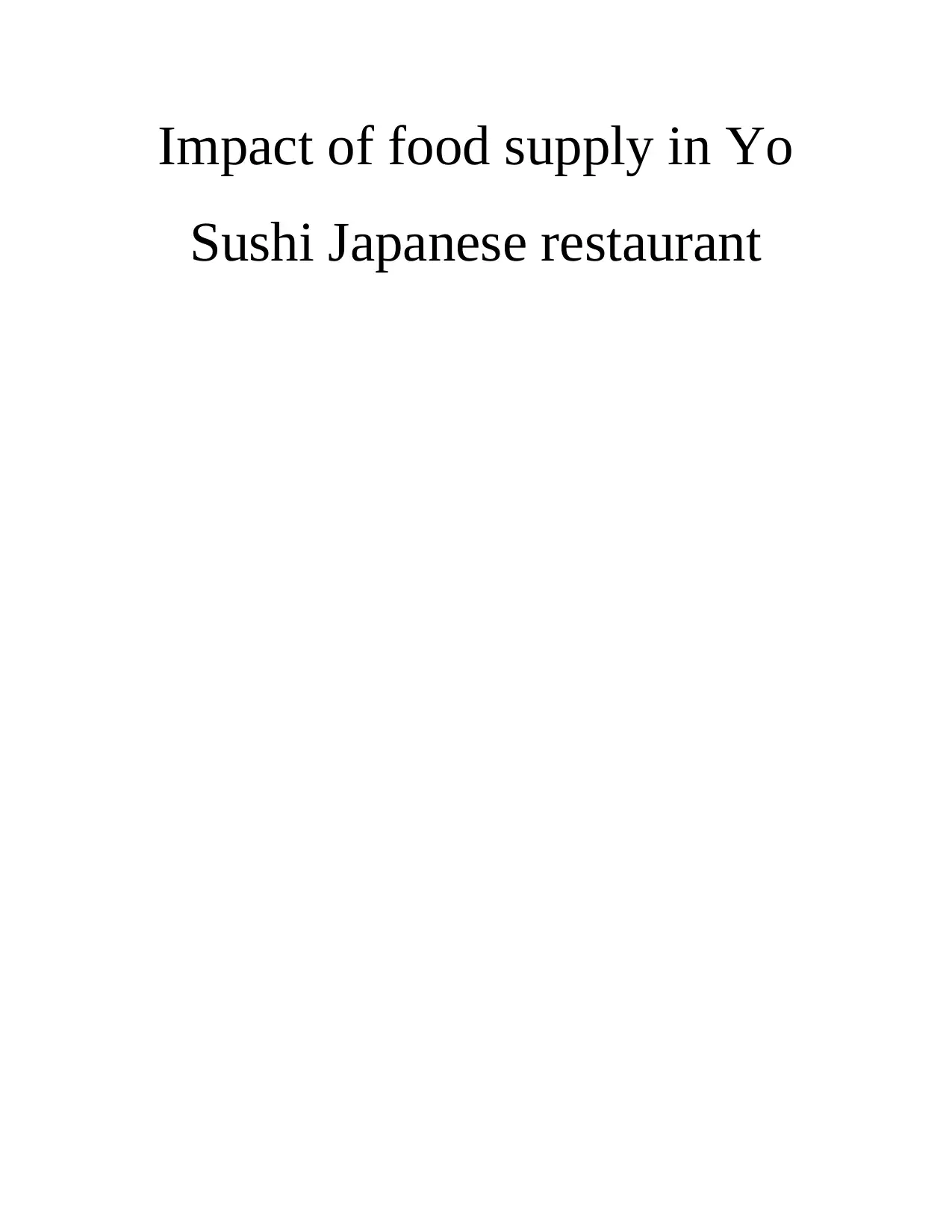
Impact of food supply in Yo
Sushi Japanese restaurant
Sushi Japanese restaurant
Paraphrase This Document
Need a fresh take? Get an instant paraphrase of this document with our AI Paraphraser
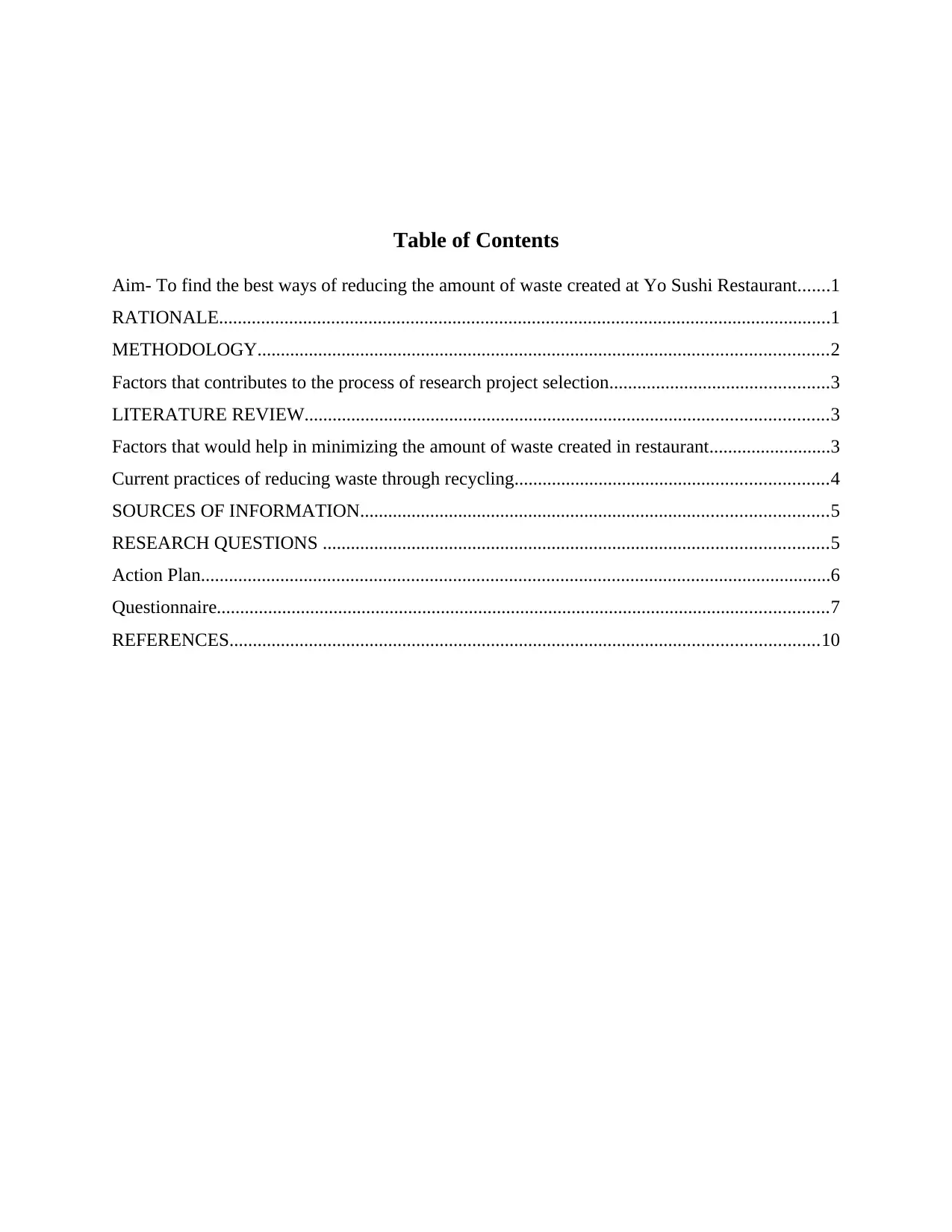
Table of Contents
Aim- To find the best ways of reducing the amount of waste created at Yo Sushi Restaurant.......1
RATIONALE...................................................................................................................................1
METHODOLOGY..........................................................................................................................2
Factors that contributes to the process of research project selection...............................................3
LITERATURE REVIEW................................................................................................................3
Factors that would help in minimizing the amount of waste created in restaurant..........................3
Current practices of reducing waste through recycling...................................................................4
SOURCES OF INFORMATION....................................................................................................5
RESEARCH QUESTIONS ............................................................................................................5
Action Plan.......................................................................................................................................6
Questionnaire...................................................................................................................................7
REFERENCES..............................................................................................................................10
Aim- To find the best ways of reducing the amount of waste created at Yo Sushi Restaurant.......1
RATIONALE...................................................................................................................................1
METHODOLOGY..........................................................................................................................2
Factors that contributes to the process of research project selection...............................................3
LITERATURE REVIEW................................................................................................................3
Factors that would help in minimizing the amount of waste created in restaurant..........................3
Current practices of reducing waste through recycling...................................................................4
SOURCES OF INFORMATION....................................................................................................5
RESEARCH QUESTIONS ............................................................................................................5
Action Plan.......................................................................................................................................6
Questionnaire...................................................................................................................................7
REFERENCES..............................................................................................................................10

⊘ This is a preview!⊘
Do you want full access?
Subscribe today to unlock all pages.

Trusted by 1+ million students worldwide
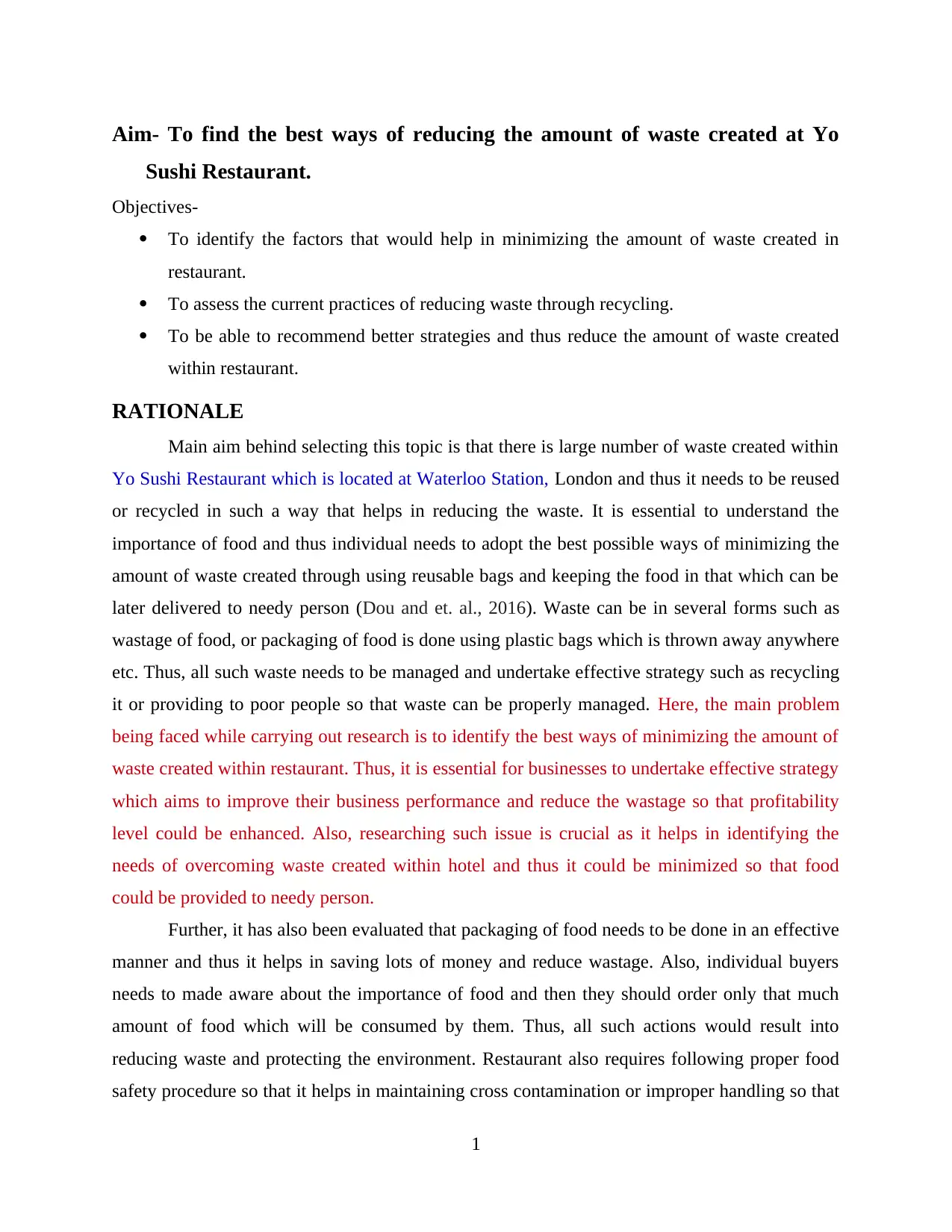
Aim- To find the best ways of reducing the amount of waste created at Yo
Sushi Restaurant.
Objectives-
To identify the factors that would help in minimizing the amount of waste created in
restaurant.
To assess the current practices of reducing waste through recycling.
To be able to recommend better strategies and thus reduce the amount of waste created
within restaurant.
RATIONALE
Main aim behind selecting this topic is that there is large number of waste created within
Yo Sushi Restaurant which is located at Waterloo Station, London and thus it needs to be reused
or recycled in such a way that helps in reducing the waste. It is essential to understand the
importance of food and thus individual needs to adopt the best possible ways of minimizing the
amount of waste created through using reusable bags and keeping the food in that which can be
later delivered to needy person (Dou and et. al., 2016). Waste can be in several forms such as
wastage of food, or packaging of food is done using plastic bags which is thrown away anywhere
etc. Thus, all such waste needs to be managed and undertake effective strategy such as recycling
it or providing to poor people so that waste can be properly managed. Here, the main problem
being faced while carrying out research is to identify the best ways of minimizing the amount of
waste created within restaurant. Thus, it is essential for businesses to undertake effective strategy
which aims to improve their business performance and reduce the wastage so that profitability
level could be enhanced. Also, researching such issue is crucial as it helps in identifying the
needs of overcoming waste created within hotel and thus it could be minimized so that food
could be provided to needy person.
Further, it has also been evaluated that packaging of food needs to be done in an effective
manner and thus it helps in saving lots of money and reduce wastage. Also, individual buyers
needs to made aware about the importance of food and then they should order only that much
amount of food which will be consumed by them. Thus, all such actions would result into
reducing waste and protecting the environment. Restaurant also requires following proper food
safety procedure so that it helps in maintaining cross contamination or improper handling so that
1
Sushi Restaurant.
Objectives-
To identify the factors that would help in minimizing the amount of waste created in
restaurant.
To assess the current practices of reducing waste through recycling.
To be able to recommend better strategies and thus reduce the amount of waste created
within restaurant.
RATIONALE
Main aim behind selecting this topic is that there is large number of waste created within
Yo Sushi Restaurant which is located at Waterloo Station, London and thus it needs to be reused
or recycled in such a way that helps in reducing the waste. It is essential to understand the
importance of food and thus individual needs to adopt the best possible ways of minimizing the
amount of waste created through using reusable bags and keeping the food in that which can be
later delivered to needy person (Dou and et. al., 2016). Waste can be in several forms such as
wastage of food, or packaging of food is done using plastic bags which is thrown away anywhere
etc. Thus, all such waste needs to be managed and undertake effective strategy such as recycling
it or providing to poor people so that waste can be properly managed. Here, the main problem
being faced while carrying out research is to identify the best ways of minimizing the amount of
waste created within restaurant. Thus, it is essential for businesses to undertake effective strategy
which aims to improve their business performance and reduce the wastage so that profitability
level could be enhanced. Also, researching such issue is crucial as it helps in identifying the
needs of overcoming waste created within hotel and thus it could be minimized so that food
could be provided to needy person.
Further, it has also been evaluated that packaging of food needs to be done in an effective
manner and thus it helps in saving lots of money and reduce wastage. Also, individual buyers
needs to made aware about the importance of food and then they should order only that much
amount of food which will be consumed by them. Thus, all such actions would result into
reducing waste and protecting the environment. Restaurant also requires following proper food
safety procedure so that it helps in maintaining cross contamination or improper handling so that
1
Paraphrase This Document
Need a fresh take? Get an instant paraphrase of this document with our AI Paraphraser
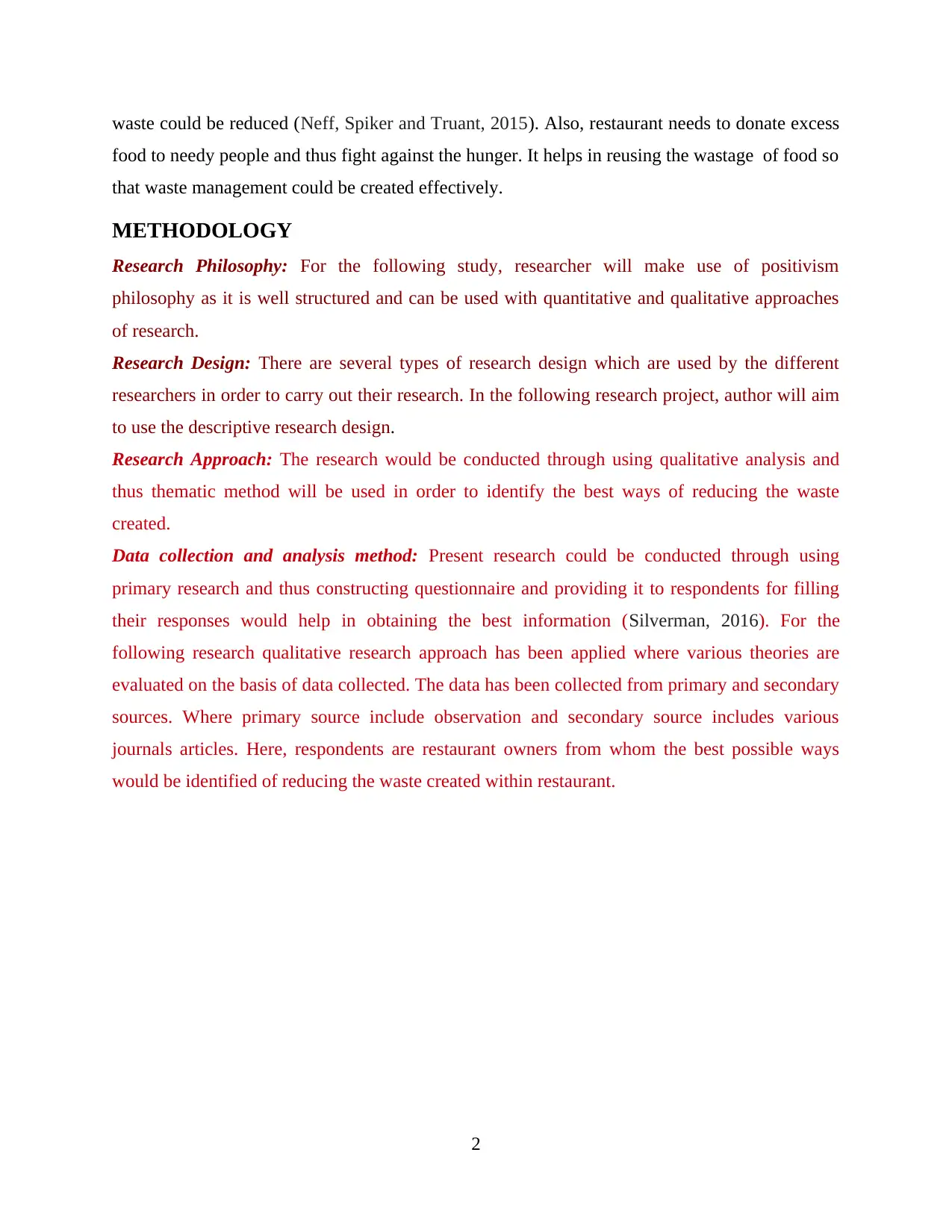
waste could be reduced (Neff, Spiker and Truant, 2015). Also, restaurant needs to donate excess
food to needy people and thus fight against the hunger. It helps in reusing the wastage of food so
that waste management could be created effectively.
METHODOLOGY
Research Philosophy: For the following study, researcher will make use of positivism
philosophy as it is well structured and can be used with quantitative and qualitative approaches
of research.
Research Design: There are several types of research design which are used by the different
researchers in order to carry out their research. In the following research project, author will aim
to use the descriptive research design.
Research Approach: The research would be conducted through using qualitative analysis and
thus thematic method will be used in order to identify the best ways of reducing the waste
created.
Data collection and analysis method: Present research could be conducted through using
primary research and thus constructing questionnaire and providing it to respondents for filling
their responses would help in obtaining the best information (Silverman, 2016). For the
following research qualitative research approach has been applied where various theories are
evaluated on the basis of data collected. The data has been collected from primary and secondary
sources. Where primary source include observation and secondary source includes various
journals articles. Here, respondents are restaurant owners from whom the best possible ways
would be identified of reducing the waste created within restaurant.
2
food to needy people and thus fight against the hunger. It helps in reusing the wastage of food so
that waste management could be created effectively.
METHODOLOGY
Research Philosophy: For the following study, researcher will make use of positivism
philosophy as it is well structured and can be used with quantitative and qualitative approaches
of research.
Research Design: There are several types of research design which are used by the different
researchers in order to carry out their research. In the following research project, author will aim
to use the descriptive research design.
Research Approach: The research would be conducted through using qualitative analysis and
thus thematic method will be used in order to identify the best ways of reducing the waste
created.
Data collection and analysis method: Present research could be conducted through using
primary research and thus constructing questionnaire and providing it to respondents for filling
their responses would help in obtaining the best information (Silverman, 2016). For the
following research qualitative research approach has been applied where various theories are
evaluated on the basis of data collected. The data has been collected from primary and secondary
sources. Where primary source include observation and secondary source includes various
journals articles. Here, respondents are restaurant owners from whom the best possible ways
would be identified of reducing the waste created within restaurant.
2
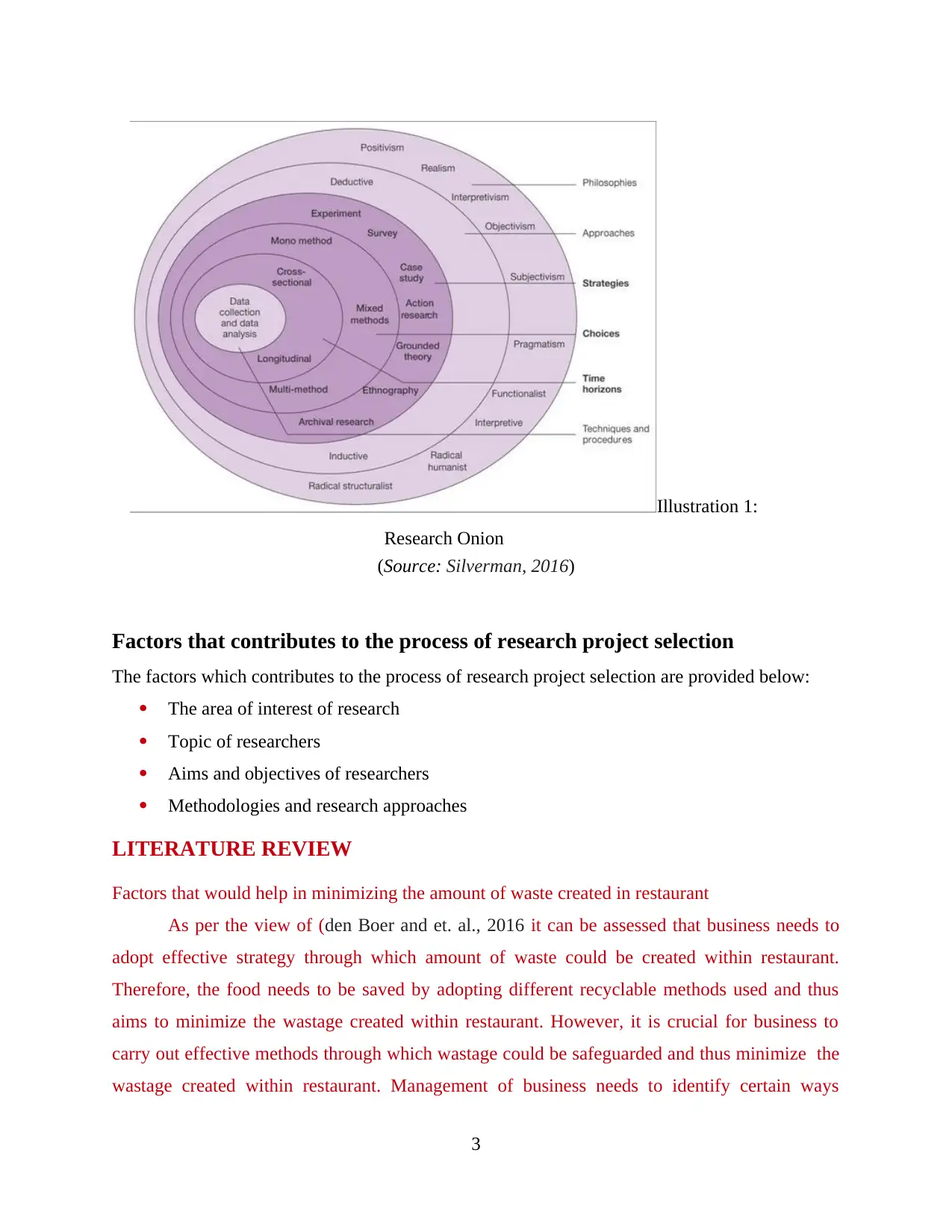
Illustration 1:
Research Onion
(Source: Silverman, 2016)
Factors that contributes to the process of research project selection
The factors which contributes to the process of research project selection are provided below:
The area of interest of research
Topic of researchers
Aims and objectives of researchers
Methodologies and research approaches
LITERATURE REVIEW
Factors that would help in minimizing the amount of waste created in restaurant
As per the view of (den Boer and et. al., 2016 it can be assessed that business needs to
adopt effective strategy through which amount of waste could be created within restaurant.
Therefore, the food needs to be saved by adopting different recyclable methods used and thus
aims to minimize the wastage created within restaurant. However, it is crucial for business to
carry out effective methods through which wastage could be safeguarded and thus minimize the
wastage created within restaurant. Management of business needs to identify certain ways
3
Research Onion
(Source: Silverman, 2016)
Factors that contributes to the process of research project selection
The factors which contributes to the process of research project selection are provided below:
The area of interest of research
Topic of researchers
Aims and objectives of researchers
Methodologies and research approaches
LITERATURE REVIEW
Factors that would help in minimizing the amount of waste created in restaurant
As per the view of (den Boer and et. al., 2016 it can be assessed that business needs to
adopt effective strategy through which amount of waste could be created within restaurant.
Therefore, the food needs to be saved by adopting different recyclable methods used and thus
aims to minimize the wastage created within restaurant. However, it is crucial for business to
carry out effective methods through which wastage could be safeguarded and thus minimize the
wastage created within restaurant. Management of business needs to identify certain ways
3
⊘ This is a preview!⊘
Do you want full access?
Subscribe today to unlock all pages.

Trusted by 1+ million students worldwide
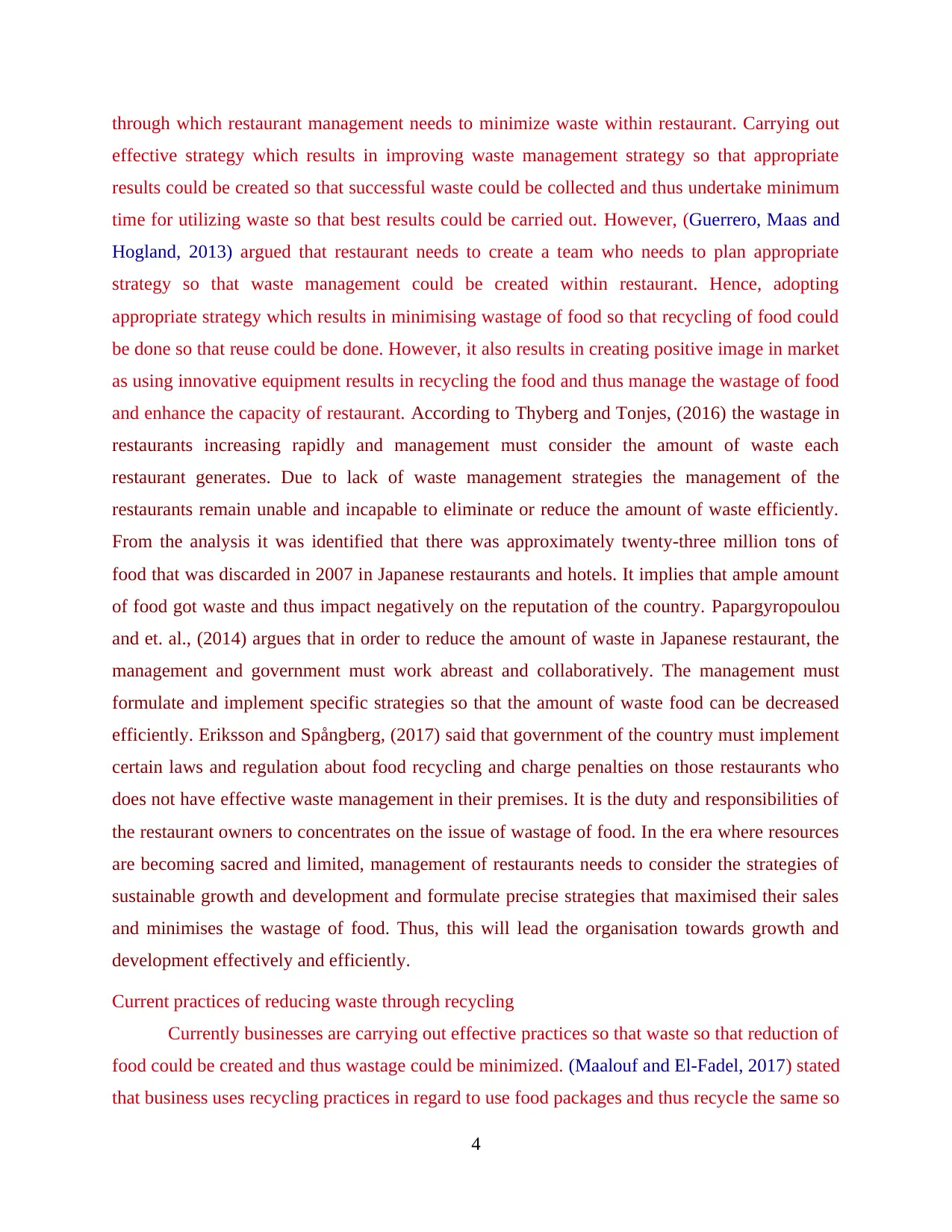
through which restaurant management needs to minimize waste within restaurant. Carrying out
effective strategy which results in improving waste management strategy so that appropriate
results could be created so that successful waste could be collected and thus undertake minimum
time for utilizing waste so that best results could be carried out. However, (Guerrero, Maas and
Hogland, 2013) argued that restaurant needs to create a team who needs to plan appropriate
strategy so that waste management could be created within restaurant. Hence, adopting
appropriate strategy which results in minimising wastage of food so that recycling of food could
be done so that reuse could be done. However, it also results in creating positive image in market
as using innovative equipment results in recycling the food and thus manage the wastage of food
and enhance the capacity of restaurant. According to Thyberg and Tonjes, (2016) the wastage in
restaurants increasing rapidly and management must consider the amount of waste each
restaurant generates. Due to lack of waste management strategies the management of the
restaurants remain unable and incapable to eliminate or reduce the amount of waste efficiently.
From the analysis it was identified that there was approximately twenty-three million tons of
food that was discarded in 2007 in Japanese restaurants and hotels. It implies that ample amount
of food got waste and thus impact negatively on the reputation of the country. Papargyropoulou
and et. al., (2014) argues that in order to reduce the amount of waste in Japanese restaurant, the
management and government must work abreast and collaboratively. The management must
formulate and implement specific strategies so that the amount of waste food can be decreased
efficiently. Eriksson and Spångberg, (2017) said that government of the country must implement
certain laws and regulation about food recycling and charge penalties on those restaurants who
does not have effective waste management in their premises. It is the duty and responsibilities of
the restaurant owners to concentrates on the issue of wastage of food. In the era where resources
are becoming sacred and limited, management of restaurants needs to consider the strategies of
sustainable growth and development and formulate precise strategies that maximised their sales
and minimises the wastage of food. Thus, this will lead the organisation towards growth and
development effectively and efficiently.
Current practices of reducing waste through recycling
Currently businesses are carrying out effective practices so that waste so that reduction of
food could be created and thus wastage could be minimized. (Maalouf and El-Fadel, 2017) stated
that business uses recycling practices in regard to use food packages and thus recycle the same so
4
effective strategy which results in improving waste management strategy so that appropriate
results could be created so that successful waste could be collected and thus undertake minimum
time for utilizing waste so that best results could be carried out. However, (Guerrero, Maas and
Hogland, 2013) argued that restaurant needs to create a team who needs to plan appropriate
strategy so that waste management could be created within restaurant. Hence, adopting
appropriate strategy which results in minimising wastage of food so that recycling of food could
be done so that reuse could be done. However, it also results in creating positive image in market
as using innovative equipment results in recycling the food and thus manage the wastage of food
and enhance the capacity of restaurant. According to Thyberg and Tonjes, (2016) the wastage in
restaurants increasing rapidly and management must consider the amount of waste each
restaurant generates. Due to lack of waste management strategies the management of the
restaurants remain unable and incapable to eliminate or reduce the amount of waste efficiently.
From the analysis it was identified that there was approximately twenty-three million tons of
food that was discarded in 2007 in Japanese restaurants and hotels. It implies that ample amount
of food got waste and thus impact negatively on the reputation of the country. Papargyropoulou
and et. al., (2014) argues that in order to reduce the amount of waste in Japanese restaurant, the
management and government must work abreast and collaboratively. The management must
formulate and implement specific strategies so that the amount of waste food can be decreased
efficiently. Eriksson and Spångberg, (2017) said that government of the country must implement
certain laws and regulation about food recycling and charge penalties on those restaurants who
does not have effective waste management in their premises. It is the duty and responsibilities of
the restaurant owners to concentrates on the issue of wastage of food. In the era where resources
are becoming sacred and limited, management of restaurants needs to consider the strategies of
sustainable growth and development and formulate precise strategies that maximised their sales
and minimises the wastage of food. Thus, this will lead the organisation towards growth and
development effectively and efficiently.
Current practices of reducing waste through recycling
Currently businesses are carrying out effective practices so that waste so that reduction of
food could be created and thus wastage could be minimized. (Maalouf and El-Fadel, 2017) stated
that business uses recycling practices in regard to use food packages and thus recycle the same so
4
Paraphrase This Document
Need a fresh take? Get an instant paraphrase of this document with our AI Paraphraser
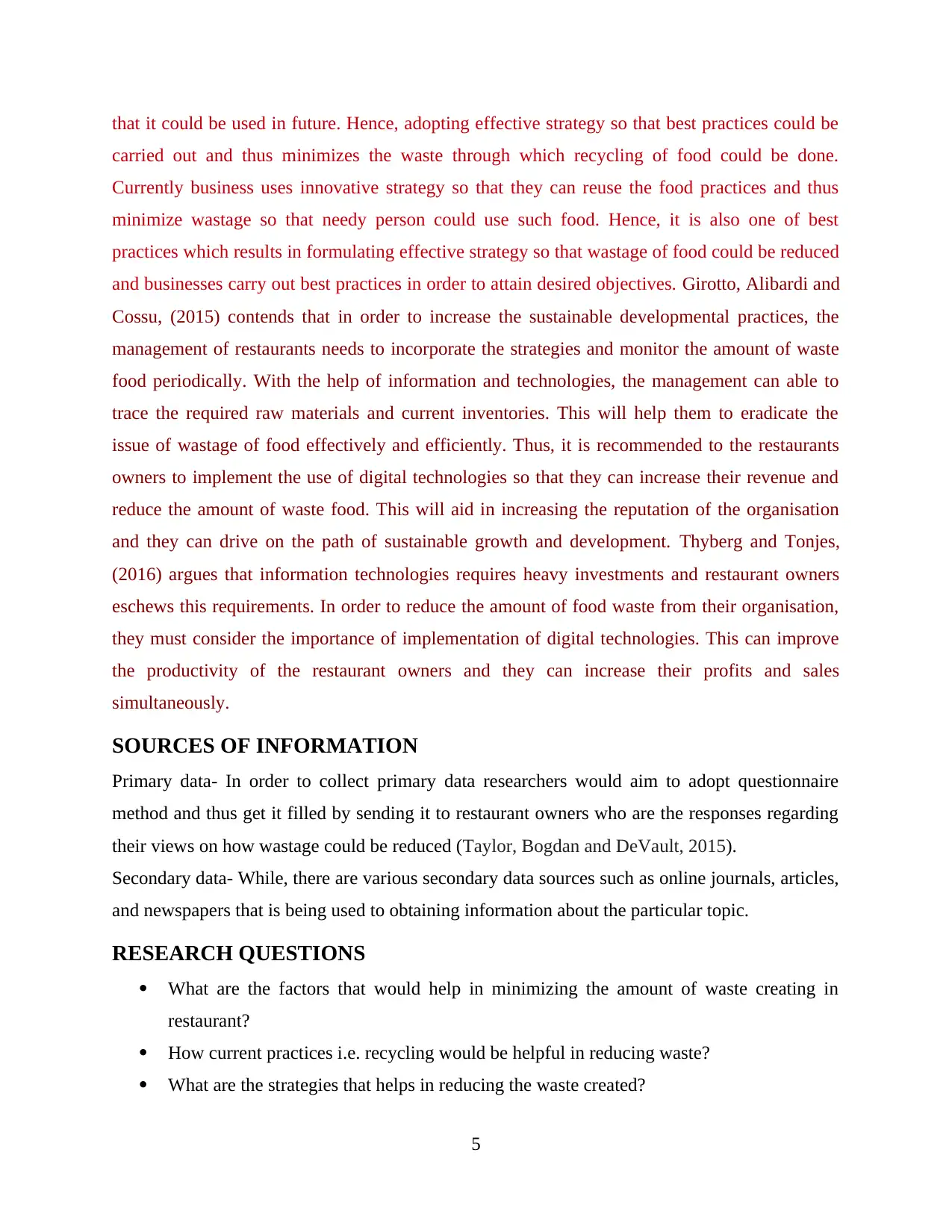
that it could be used in future. Hence, adopting effective strategy so that best practices could be
carried out and thus minimizes the waste through which recycling of food could be done.
Currently business uses innovative strategy so that they can reuse the food practices and thus
minimize wastage so that needy person could use such food. Hence, it is also one of best
practices which results in formulating effective strategy so that wastage of food could be reduced
and businesses carry out best practices in order to attain desired objectives. Girotto, Alibardi and
Cossu, (2015) contends that in order to increase the sustainable developmental practices, the
management of restaurants needs to incorporate the strategies and monitor the amount of waste
food periodically. With the help of information and technologies, the management can able to
trace the required raw materials and current inventories. This will help them to eradicate the
issue of wastage of food effectively and efficiently. Thus, it is recommended to the restaurants
owners to implement the use of digital technologies so that they can increase their revenue and
reduce the amount of waste food. This will aid in increasing the reputation of the organisation
and they can drive on the path of sustainable growth and development. Thyberg and Tonjes,
(2016) argues that information technologies requires heavy investments and restaurant owners
eschews this requirements. In order to reduce the amount of food waste from their organisation,
they must consider the importance of implementation of digital technologies. This can improve
the productivity of the restaurant owners and they can increase their profits and sales
simultaneously.
SOURCES OF INFORMATION
Primary data- In order to collect primary data researchers would aim to adopt questionnaire
method and thus get it filled by sending it to restaurant owners who are the responses regarding
their views on how wastage could be reduced (Taylor, Bogdan and DeVault, 2015).
Secondary data- While, there are various secondary data sources such as online journals, articles,
and newspapers that is being used to obtaining information about the particular topic.
RESEARCH QUESTIONS
What are the factors that would help in minimizing the amount of waste creating in
restaurant?
How current practices i.e. recycling would be helpful in reducing waste?
What are the strategies that helps in reducing the waste created?
5
carried out and thus minimizes the waste through which recycling of food could be done.
Currently business uses innovative strategy so that they can reuse the food practices and thus
minimize wastage so that needy person could use such food. Hence, it is also one of best
practices which results in formulating effective strategy so that wastage of food could be reduced
and businesses carry out best practices in order to attain desired objectives. Girotto, Alibardi and
Cossu, (2015) contends that in order to increase the sustainable developmental practices, the
management of restaurants needs to incorporate the strategies and monitor the amount of waste
food periodically. With the help of information and technologies, the management can able to
trace the required raw materials and current inventories. This will help them to eradicate the
issue of wastage of food effectively and efficiently. Thus, it is recommended to the restaurants
owners to implement the use of digital technologies so that they can increase their revenue and
reduce the amount of waste food. This will aid in increasing the reputation of the organisation
and they can drive on the path of sustainable growth and development. Thyberg and Tonjes,
(2016) argues that information technologies requires heavy investments and restaurant owners
eschews this requirements. In order to reduce the amount of food waste from their organisation,
they must consider the importance of implementation of digital technologies. This can improve
the productivity of the restaurant owners and they can increase their profits and sales
simultaneously.
SOURCES OF INFORMATION
Primary data- In order to collect primary data researchers would aim to adopt questionnaire
method and thus get it filled by sending it to restaurant owners who are the responses regarding
their views on how wastage could be reduced (Taylor, Bogdan and DeVault, 2015).
Secondary data- While, there are various secondary data sources such as online journals, articles,
and newspapers that is being used to obtaining information about the particular topic.
RESEARCH QUESTIONS
What are the factors that would help in minimizing the amount of waste creating in
restaurant?
How current practices i.e. recycling would be helpful in reducing waste?
What are the strategies that helps in reducing the waste created?
5
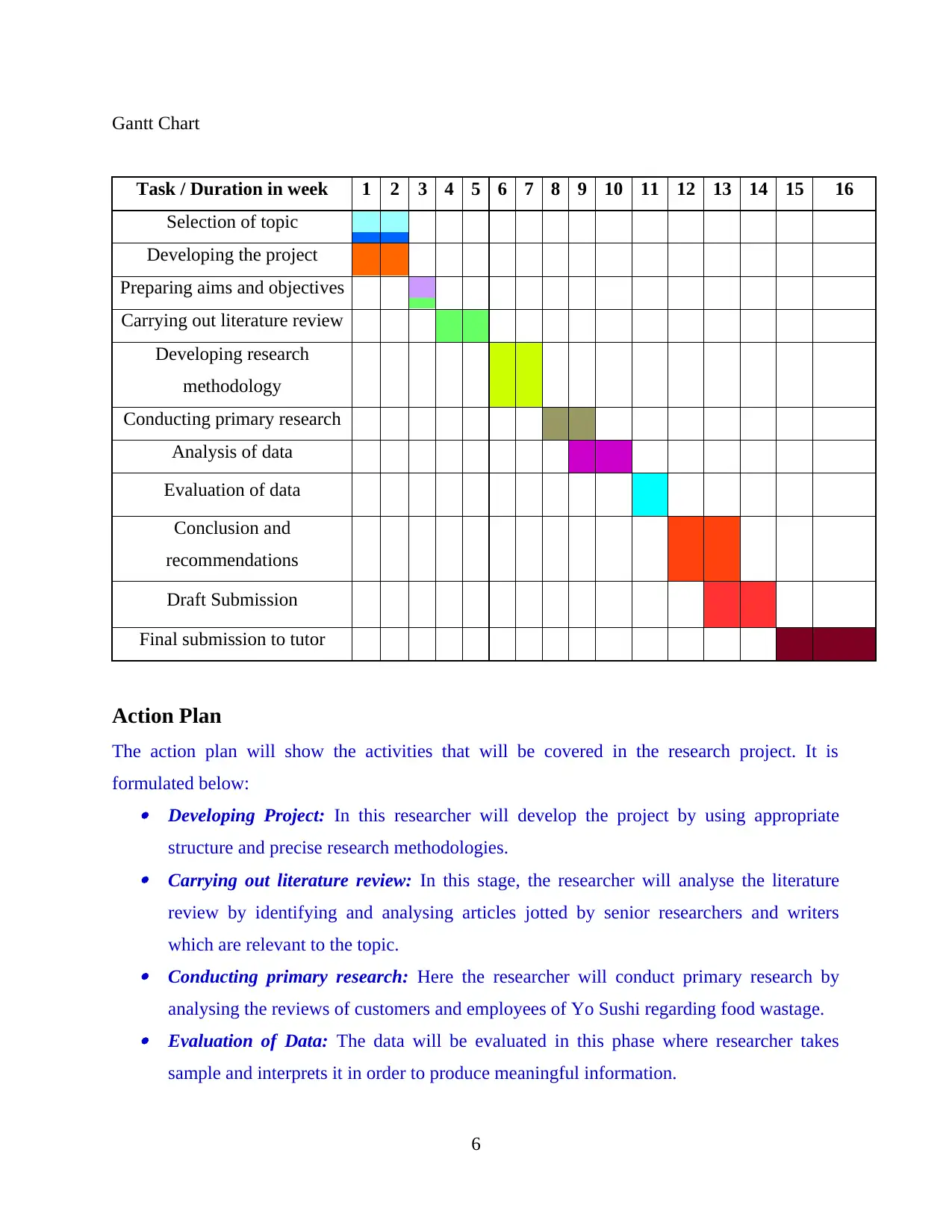
Gantt Chart
Task / Duration in week 1 2 3 4 5 6 7 8 9 10 11 12 13 14 15 16
Selection of topic
Developing the project
Preparing aims and objectives
Carrying out literature review
Developing research
methodology
Conducting primary research
Analysis of data
Evaluation of data
Conclusion and
recommendations
Draft Submission
Final submission to tutor
Action Plan
The action plan will show the activities that will be covered in the research project. It is
formulated below: Developing Project: In this researcher will develop the project by using appropriate
structure and precise research methodologies. Carrying out literature review: In this stage, the researcher will analyse the literature
review by identifying and analysing articles jotted by senior researchers and writers
which are relevant to the topic. Conducting primary research: Here the researcher will conduct primary research by
analysing the reviews of customers and employees of Yo Sushi regarding food wastage. Evaluation of Data: The data will be evaluated in this phase where researcher takes
sample and interprets it in order to produce meaningful information.
6
Task / Duration in week 1 2 3 4 5 6 7 8 9 10 11 12 13 14 15 16
Selection of topic
Developing the project
Preparing aims and objectives
Carrying out literature review
Developing research
methodology
Conducting primary research
Analysis of data
Evaluation of data
Conclusion and
recommendations
Draft Submission
Final submission to tutor
Action Plan
The action plan will show the activities that will be covered in the research project. It is
formulated below: Developing Project: In this researcher will develop the project by using appropriate
structure and precise research methodologies. Carrying out literature review: In this stage, the researcher will analyse the literature
review by identifying and analysing articles jotted by senior researchers and writers
which are relevant to the topic. Conducting primary research: Here the researcher will conduct primary research by
analysing the reviews of customers and employees of Yo Sushi regarding food wastage. Evaluation of Data: The data will be evaluated in this phase where researcher takes
sample and interprets it in order to produce meaningful information.
6
⊘ This is a preview!⊘
Do you want full access?
Subscribe today to unlock all pages.

Trusted by 1+ million students worldwide
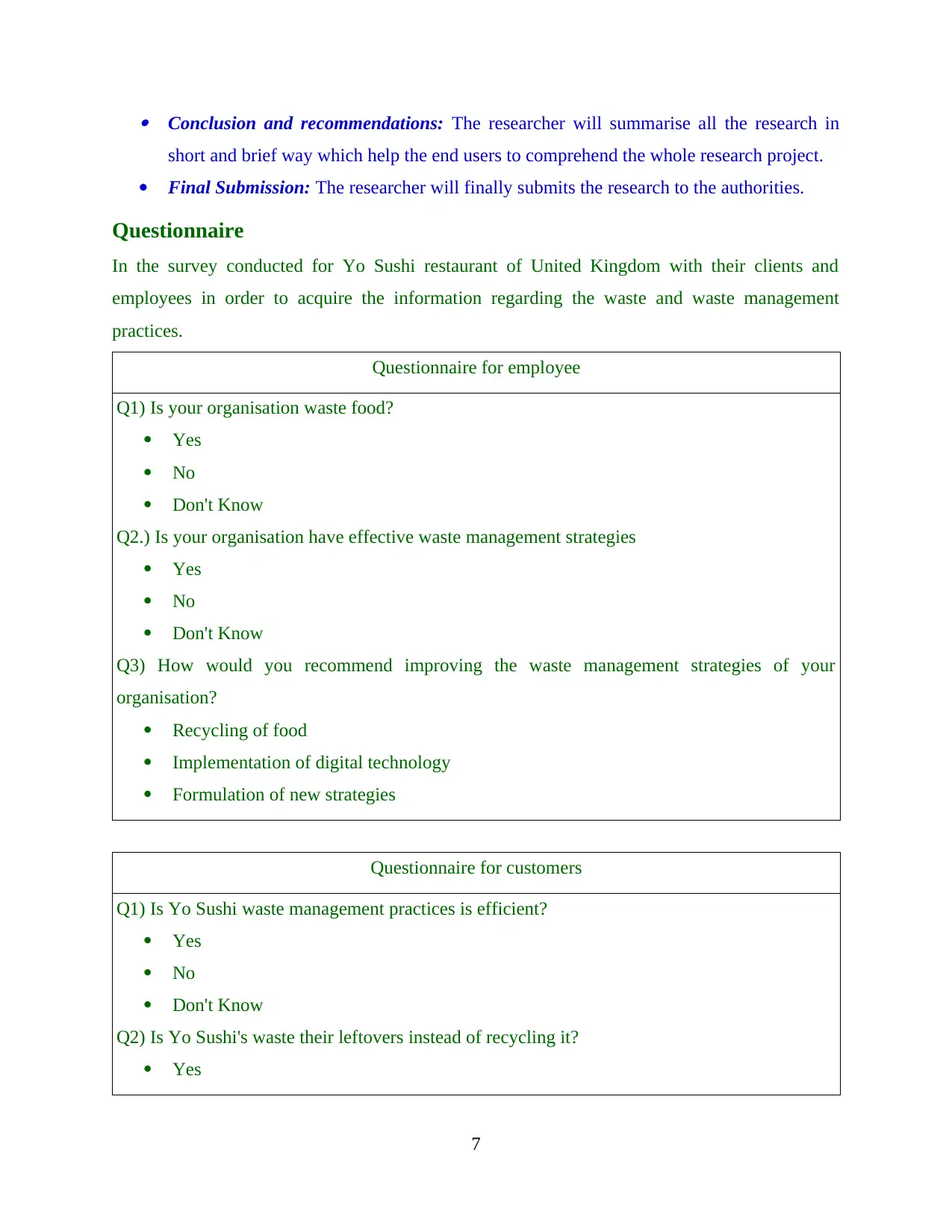
Conclusion and recommendations: The researcher will summarise all the research in
short and brief way which help the end users to comprehend the whole research project.
Final Submission: The researcher will finally submits the research to the authorities.
Questionnaire
In the survey conducted for Yo Sushi restaurant of United Kingdom with their clients and
employees in order to acquire the information regarding the waste and waste management
practices.
Questionnaire for employee
Q1) Is your organisation waste food?
Yes
No
Don't Know
Q2.) Is your organisation have effective waste management strategies
Yes
No
Don't Know
Q3) How would you recommend improving the waste management strategies of your
organisation?
Recycling of food
Implementation of digital technology
Formulation of new strategies
Questionnaire for customers
Q1) Is Yo Sushi waste management practices is efficient?
Yes
No
Don't Know
Q2) Is Yo Sushi's waste their leftovers instead of recycling it?
Yes
7
short and brief way which help the end users to comprehend the whole research project.
Final Submission: The researcher will finally submits the research to the authorities.
Questionnaire
In the survey conducted for Yo Sushi restaurant of United Kingdom with their clients and
employees in order to acquire the information regarding the waste and waste management
practices.
Questionnaire for employee
Q1) Is your organisation waste food?
Yes
No
Don't Know
Q2.) Is your organisation have effective waste management strategies
Yes
No
Don't Know
Q3) How would you recommend improving the waste management strategies of your
organisation?
Recycling of food
Implementation of digital technology
Formulation of new strategies
Questionnaire for customers
Q1) Is Yo Sushi waste management practices is efficient?
Yes
No
Don't Know
Q2) Is Yo Sushi's waste their leftovers instead of recycling it?
Yes
7
Paraphrase This Document
Need a fresh take? Get an instant paraphrase of this document with our AI Paraphraser
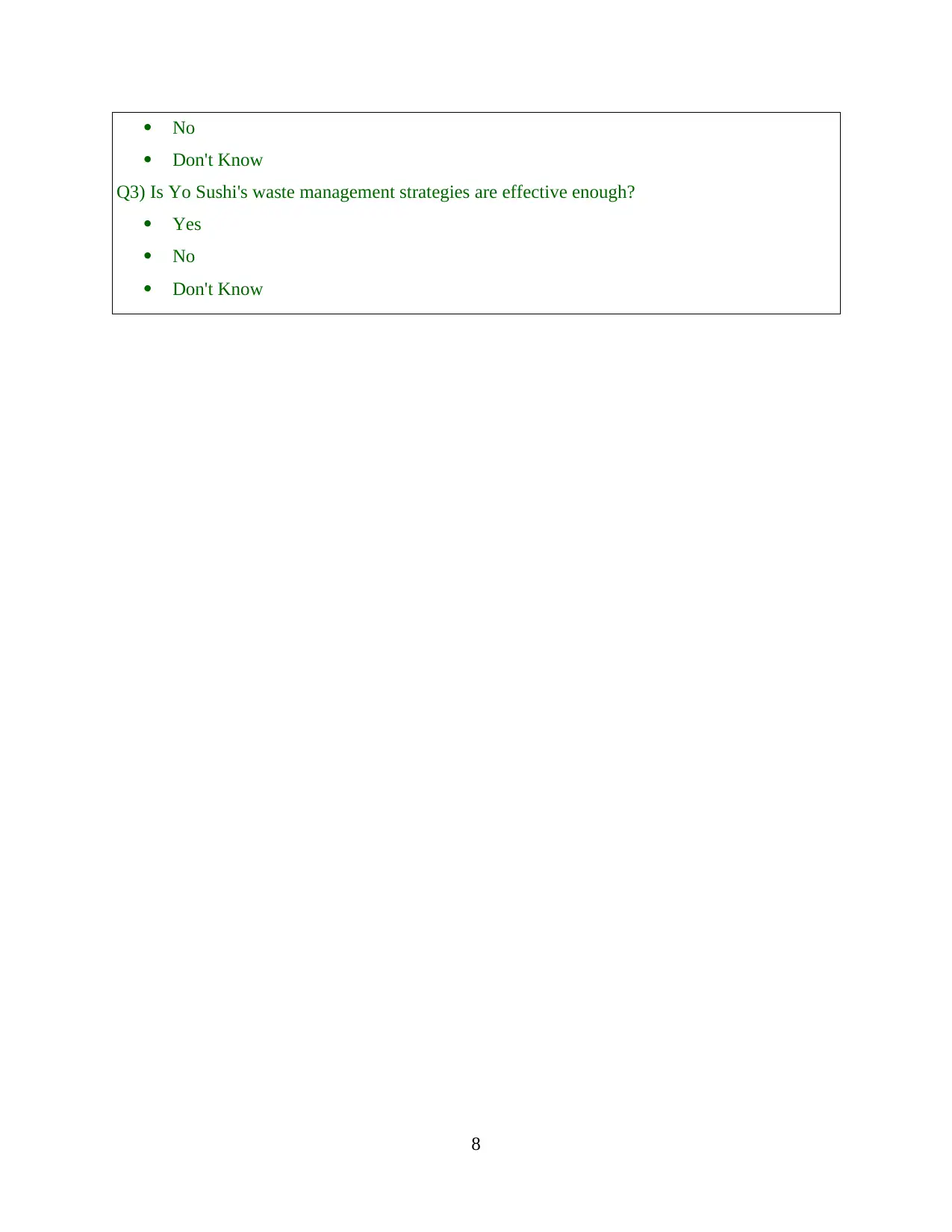
No
Don't Know
Q3) Is Yo Sushi's waste management strategies are effective enough?
Yes
No
Don't Know
8
Don't Know
Q3) Is Yo Sushi's waste management strategies are effective enough?
Yes
No
Don't Know
8

9
⊘ This is a preview!⊘
Do you want full access?
Subscribe today to unlock all pages.

Trusted by 1+ million students worldwide
1 out of 13
Related Documents
Your All-in-One AI-Powered Toolkit for Academic Success.
+13062052269
info@desklib.com
Available 24*7 on WhatsApp / Email
![[object Object]](/_next/static/media/star-bottom.7253800d.svg)
Unlock your academic potential
Copyright © 2020–2025 A2Z Services. All Rights Reserved. Developed and managed by ZUCOL.





